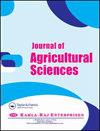Effects of Heat Stress after Anthesis on PSII Photochemical Efficiency and the Antioxidant Activity of Wheat Cultivars
IF 0.7
Q3 AGRICULTURE, MULTIDISCIPLINARY
引用次数: 2
Abstract
This study was conducted to investigate the effects of heat stress after anthesis on the performance of Photosystem II (PSII) and the enzymatic activity of catalase and ascorbate peroxidase. Two treatments-normal and heat stress-were conducted on four bread wheat cultivars from 7 days after anthesis until maturity. Heat stress led to an acceleration of chlorosis, reduced the efficiency of electron transfer and increased concentrations of malondialdehyde; however, the level of susceptibility varied depending on the cultivars. On the 10th day of heat stress, reductions in fluorescence parameters, depending on the cultivar, were 6.9 to 18.9% for Fv/Fm, 9 to 21% for ΦPSII and 8.3 to 19.4% for F’v/F’m compared to normal conditions. Catalase activity increased after initial exposure to heat stress. However, after 10 days of treatment, catalase activity increased in the Chamran and Aflak cultivars by 32% and 45%, respectively, but it did not change in the Dez cultivar and decreased 22% in Darab2. Ascorbate peroxidase activity decreased in two treatments, while the amount of reduction in heat stress treatment was more than the normal treatment. The highest levels of enzymatic activity were observed in Chamran under heat stress conditions, whereas Darab2 and Dez showed the lowest activity of the enzymes. Chlorophyll fluorescence parameters and chlorophyll index had a significant negative correlation with the levels of malondialdehyde; however, they had a significant positive correlation with the antioxidant activity.花后热胁迫对小麦品种PSII光化学效率及抗氧化活性的影响
本试验旨在研究开花后热胁迫对苜蓿光系统II (PSII)性能及过氧化氢酶和抗坏血酸过氧化物酶活性的影响。对4个面包小麦品种从开花后7 d至成熟进行了正常胁迫和热胁迫处理。热应激导致黄化加速,电子传递效率降低,丙二醛浓度增加;然而,不同品种的敏感性不同。在热胁迫第10天,不同品种的荧光参数与正常条件相比,Fv/Fm降低了6.9 ~ 18.9%,ΦPSII降低了9 ~ 21%,F’v/F’m降低了8.3 ~ 19.4%。过氧化氢酶活性在初始暴露于热应激后增加。然而,处理10天后,Chamran和Aflak品种过氧化氢酶活性分别提高了32%和45%,而Dez品种没有变化,Darab2下降了22%。抗坏血酸过氧化物酶活性在两个处理中均有所下降,但热应激处理的下降幅度大于正常处理。热胁迫条件下Chamran的酶活性最高,而Darab2和Dez的酶活性最低。叶绿素荧光参数和叶绿素指数与丙二醛水平呈显著负相关;然而,它们与抗氧化活性呈显著正相关。
本文章由计算机程序翻译,如有差异,请以英文原文为准。
求助全文
约1分钟内获得全文
求助全文
来源期刊

Journal of Agricultural Sciences
AGRICULTURE, MULTIDISCIPLINARY-
CiteScore
1.80
自引率
0.00%
发文量
0
 求助内容:
求助内容: 应助结果提醒方式:
应助结果提醒方式:


